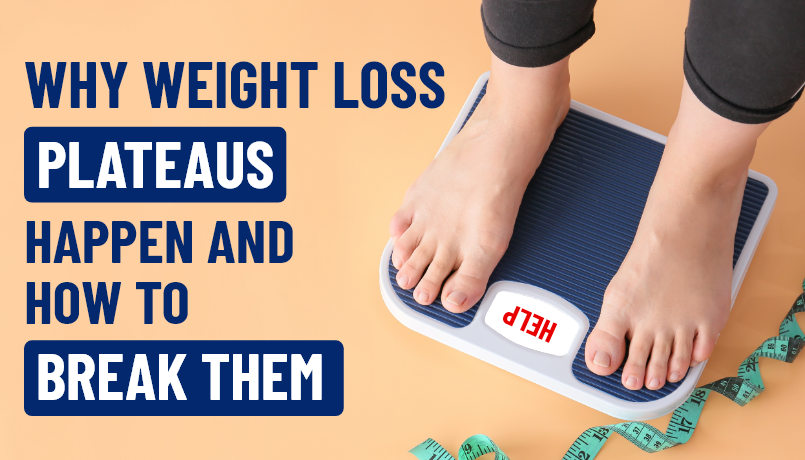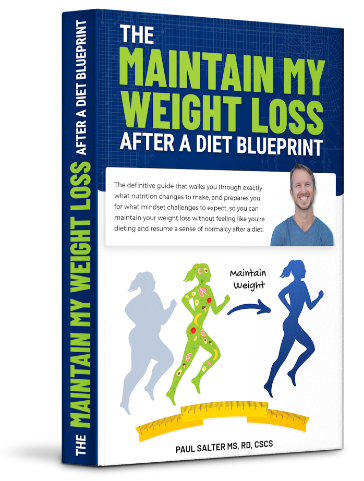Why Weight Loss Plateaus Happen and How To Break Them

One of the biggest frustrations after beginning a diet you’ll encounter is a weight loss plateau. In other words, a stall on the scale. A weight loss plateau may be defined as a period in which you temporarily stop losing weight during a diet. This can prove to be a frustrating experience. A weight loss plateau creates the perception that hard work, sacrifice, and commitment are not paying off. (In truth, though, they really are).
In this article, we’ll discuss how to determine if your change in weight is truly a plateau. Alternatively, you may need to simply be more patient in allowing your previous adjustments ample time to play out. Additionally, we’ll discuss why a weight loss plateau occurs. We’ll dive into potential reasons they occur, and what you can do to break them.
A Weight Loss Plateau Is Not A Bad Thing
It’s easy to view a weight loss plateau as a bad thing. The truth is that it’s a normal part of the weight loss journey. In fact, it’s actually a positive sign that your body – specifically your metabolism – is humming along as it should be.
When you begin a diet by eating fewer calories than you need, this places significant physiological stress on the body. Your body shifts focus to prioritize doing everything it can to bring you out of this calorie deficit (to remove the stress).
Some of the adaptations it makes include:
- Reducing the number of calories you burn throughout the day and during your workouts
- Increasing production of the appetite-stimulating hormone, ghrelin
- Decreasing production of the appetite-suppressing hormone, leptin
- Reducing the amount of energy present throughout the day
These changes collectively work to either get you to eat more or experience a reduction in energy expenditure. Both of these options ultimately lead to a plateau on the scale. The degree to which the number on the scale does or does not change is important to recognize before immediately labeling it as a plateau.
Pro Tip: You’ll need further information on the physiological and psychological adaptations that take place during a diet to prevent you from losing weight. Check out episode 171 of The 5% Way Podcast, “Why You’re Primed for Weight Regain After A Diet.”
How to Determine if It’s Really A Weight Loss Plateau
As mentioned above, a weight loss plateau may be defined as a period in which you temporarily stop losing weight. But it’s important to understand how to recognize whether a plateau really is present. Sometimes you’re being a bit eager to see weight loss at a quicker pace.
Like you, when dieting, I want the weight to come off much faster than it usually does; however, this can prove problematic if you push progress too quickly.
The recommended rate of weight loss when seeking significant, sustainable progress is between 0.5 – 1.0 percent of your body weight per week. For example, this shakes out to one to two pounds per week for a 200-pound individual. Losing weight any faster than this significantly increases your risk for weight regain after you finish dieting.
To help you determine whether a weight loss plateau is present, it’s important that you’re appropriately tracking your weight.
How To Track Your Weight
Here are the steps I’ve used the past decade with the thousands I’ve worked one-on-one with. Using these steps, we ensure we have reliable data to discern whether a true plateau is present.
- I have my clients weigh themselves first thing in the morning in minimal clothing after using the restroom.
- I have my clients weigh themselves two or three days per week (some weigh themselves more if they’re detached from the scale number).
- We use their multiple weekly weigh-ins to generate an average weight for the week.
- We then compare one weekly average to another to best determine if a plateau is present and whether or not an adjustment is needed.
If you’re looking for more information to determine the ideal weigh-in frequency for you, check out this article that discusses the research on the pros and cons of weighing in more or less frequently.
Pro Tip: Remember that it’s normal for your weight to fluctuate a few pounds each day. This is why taking multiple weights per week and finding an average is helpful. It minimizes the impact of natural fluctuation when trying to discern what trend is present.
Guidelines Surrounding Weight Loss Plateaus
You will compare weekly averages to one another during a diet to determine when another nutrition adjustment may be needed. Here are guidelines to keep in mind before declaring a plateau is present and adjustment imminent:
- If the current week’s average is higher than the previous week’s, it’s likely a sign we’ve reached a plateau. You may need to proactively adjust your portions accordingly
- If the current week’s average is roughly the same as the past week (within 0.5 – 1.0 pounds), go back one week further to determine how the present week compares to see if a trend is present. If there’s no true trend, proactively making an adjustment to your portions is best. If there is, don’t touch a thing quite yet.
- If the current week’s average is slightly down, determine whether it’s at a rate within the recommended 0.5 – 1.0 percent of body weight per week. If it is, don’t make adjustments. If it’s not, but still down, consider a proactive portion adjustment.
Pro Tip: Remember that the goal during a diet is to lose weight at an optimal and sustainable rate while eating as much as possible. If you’re losing weight – even slower than you desire – within that optimal rate, don’t touch a thing.
Think about it like this: why eat 1,200 calories per day to drive weight loss when you could be eating 1,600 calories and still lose weight?
3 Reasons Why Weight Loss Plateaus Happen (and How to Overcome Each)
1) You’re moving less than you think (or not as much as you used to).
As mentioned above, it’s natural to experience a decline in energy as you get further into a diet. This occurs due to your body working hard to conserve energy. This may show up in taking fewer steps per day, spending more time in front of a screen, or lack of effort or intensity during your usual workouts.
Action Step: Track your daily step count and set a daily goal. Your goal doesn’t have to be 10,000 steps per day. Instead, track your current daily step count for a week and find the average. Then, set a goal of 1,000 steps per day and do not miss it.
2) You’re eating more than you think.
Nutrition labels and tracking apps can range in degree of inaccuracy by as much as 70 percent. That’s a conversation for a different day. (Yes, sadly, it’s true…). What I focus on is whether you eat the portions you’re supposed to be eating day after day, seven days per week.
Consistent adherence is key for achieving significant, sustainable results. If you only eat on plan a few days per week, or, you eat a bit more than you’re supposed to each day, you’re minimizing (or erasing) the calorie deficit necessary for weight loss to occur.
Action Step: Commit to 100 percent compliance to your portion goals. Period. And, track your food intake by hand to help you become more intimately aware of how well you’re doing.
3) It’s simply time to make another adjustment to your nutrition or exercise.
Again, a weight loss plateau is normal and inevitable. If you’re confident that you’re experiencing a weight loss plateau, it may simply be time to make a reduction in your portions, an increase in your exercise, or, a combination of both to recreate the calorie deficit necessary for weight loss to occur.
Action Step: Make your next diet adjustment (something we teach you how to do, as well as when, why, and what to do in The 5% Fundamentals Program).
Additional Factors That Influence A Weight Loss Plateau
In addition to the primary reasons shared above, you may also want to consider assessing the following areas to determine the impact they may or may not be having:
- Stress Levels: chronic stress increases the production of the hormone cortisol, which promotes fluid retention. This can mask changes taking place on the scale.
- Sleep Quality and Quantity: Lower quality and less sleep negatively impact stress levels, energy, and appetite management, each of which contributes to changes on the scale.
- Fluid Intake: When you’re well-hydrated, your metabolism has the opportunity to operate at maximum capacity. (Everything else functions optimally, too). Aim to drink at least 60 percent of your body weight in ounces each day (all fluids count).
A Weight Loss Plateau is Expected, Normal, and Part of the Journey
Don’t forget that.
It’s not a reason to make an irrational nutrition or exercise adjustment, nor a reason to throw in the towel on your diet just yet.
It’s a natural physiological response from the body when faced with a diet and when you recognized this is occurring, you can proactively get ahead of it to keep your weight change trend heading in the right direction of your happy weight.
When you’re ready to gain proficiency in understanding when, how, and why to make specific nutrition changes during a diet to yield maximal weight-loss results, then it’s time to check out our course and program experience that teaches you the fundamentals of achieving sustainable weight loss: The 5% Fundamentals Program.

The 5% Fundamentals Program is a three-month introductory crash course experience to my signature Significant Sustainable Weight-Loss Formula that focuses on providing you with the why behind essential pre, during, and post-diet changes to help guarantee sustainable weight loss.
This program and coaching experience will teach you the most important information and strategies you need to build a foundation of healthy eating habits that empower you to best prepare for a successful diet, to execute a successful diet that delivers significant weight loss while feeling easy (yes, you read that right), and to maintain your hard-earned results without sacrificing your social life.
Click here to sign up now.
Share this post
 Paul Salter
Paul Salter

[…] You tell yourself that you’ll “always be overweight” or “can’t do this” when you reach a plateau on the scale. This leads to you throwing in the towel (mental), or remaining inactive when stress, anxiety, or […]
[…] You tell yourself that you’ll “always be overweight” or “can’t do this” when you reach a plateau on the scale. This leads to you throwing in the towel (mental), or remaining inactive when stress, anxiety, or […]
[…] more information on why weight loss plateaus exist, why they’re normal, and how to break them, open this recent article in a new tab and read it […]